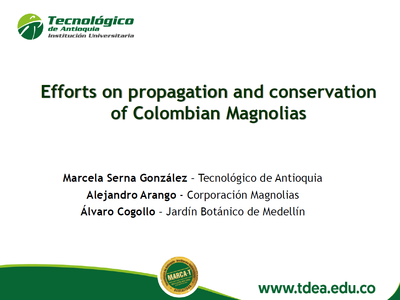Efforts on propagation and conservation of Colombian Magnolias
MARCELA SERNA-GONZÁLEZ1, FABIO ALEJANDRO ARANGO ARIAS2 & ÁLVARO COGOLLO3
- Tecnológico de Antioquia – Institución Universitaria, Medellín, Colombia.
- Corporación Magnolias, Jardín, Colombia.
- Jardín Botánico de Medellín, Joaquín Antonio Uribe, Medellín, Colombia.
Magnoliaceae was chosen as a priority group for conservation in Colombia since 2001, according to the following criteria: wide distribution in the country, most species are endangered and its species are relatively well known thanks to the taxonomic work by Doctor Gustavo Lozano who died in 2002. Thanks to the efforts by several people and organizations such as Medellin Botanical Garden, Corporación Autónoma Regional del Centro de Antioquia, Corantioquia, Tecnológico de Antioquia and Instituto de investigación de recursos biológicos Alexander von Humboldt, Colombia has 39 species described so far. Most of the Colombian species are seriously threatened (Critically Endangered, Endangered or Vulnerable) due to their restricted geographical distribution, forest disturbance, overharvesting, small and isolated populations and difficulties for propagation. The very low seedling recruitment observed in natural populations of several species such as Magnolia espinalii, M. jardinensis and M. yarumalensis, suggests that forest fragmentation could affect tree reproduction. However, seeds of some species exhibit relatively high germination levels in the laboratory with different substrates: soil, sand and sand with rice husk (i.e. M. jardinensis) although in other species, the germination percentage is still low (i.e. M. yarumalensis). The objective of this presentation is to show our results of propagation based on phenology assessments, differences of germination percentage among these species in the nursery and the probable aspects affecting their growth and development. Research related to seedling pathogens and easy protocols to improve germination processes need to be addressed as the first step to improve the status of wild populations in order to guarantee effective conservation projects.

